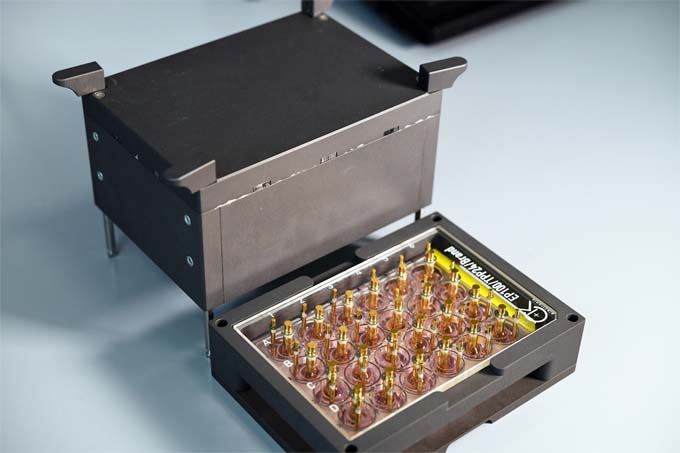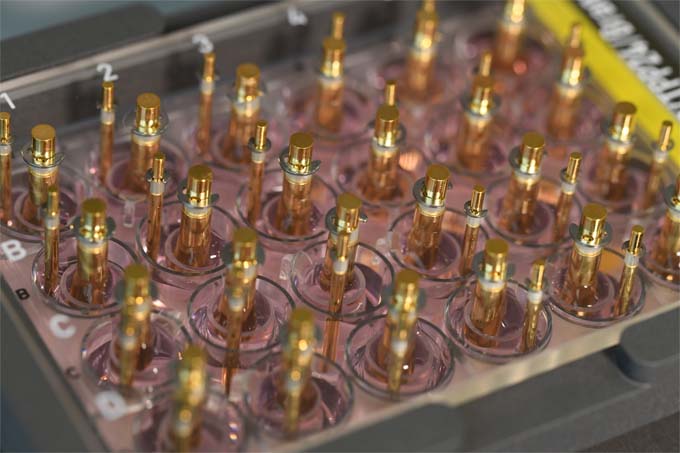In vitro eye irritation test instead of standard animal test
In order to test possible harmful effects of chemicals on eye contact, this has so far been investigated using the Draize test on live rabbits, which is used worldwide. Researchers at the Translational Center for Regenerative Therapies TLZ of the Fraunhofer Institute for Silicate Research ISC, together with partners, now want to replace animal testing with tissue models of the human cornea cultivated in the laboratory.

Each and every one of us has certainly experienced it: Soap gets into the eye while showering, and it burns and itches. But the consequences are much more dramatic when stronger chemical substances, such as those found in household products, get into the eye. One drop of acid is enough to damage the cornea of our exposed and sensitive visual organ and leave a permanent scar. A few drops of alkaline solutions can even cloud the entire cornea forever. That's why experts have been studying the potential risk of eye irritation from chemicals since 1944 using the Draize test. In this test, substances are dripped into the eyes of rabbits. After days, the chemical substances are then classified: into GHS category 1 (Globally Harmonized System of Classification and Labelling of Chemicals) for irreversible damage, GHS category 2 for reversible damage, or into chemicals that do not require labeling because they are not harmful.
Standard animal experiment frowned upon
However, animal testing has been discredited for years. Scientists around the world are therefore working hard to find alternatives. Until now, however, it has not been possible to reliably distinguish between irreversible and reversible damage without animal testing, meaning that a complete replacement for the Draize test has not been possible. Researchers at the Fraunhofer Translational Center for Regenerative Therapies TLZ at Fraunhofer ISC in Würzburg are currently working with partners from industry and research to develop an impedance-based in vitro test system that will make this distinction possible. At the same time, it is to be submitted to the Organization for Economic Cooperation and Development OECD and established as a new testing guideline.
Impedance based eye damage test
The new test method combines a modified cornea model based on human tissue models with non-invasive impedance spectroscopy. "We first grow human tissue in the laboratory that replicates the anterior part of the cornea, the cornea. The tissue cells are encased in a cell membrane that acts like an electrical insulator due to its chemical composition. If the cells form one or more closed layers, then a measurable resistance is created. The barrier properties of epithelia, the outermost layer of the cornea, can be determined using electrical resistance," says Dr. Christian Lotz, a scientist at the Fraunhofer TLZ, explaining the principle. If a test substance causes damage to the eye, the barrier is destroyed, cells die, holes appear and the resistance drops. The current can flow freely again. The more cell layers die, the further the resistance drops. In this way, the condition of the tissue can be measured indirectly with the impedance spectrometer without destroying the tissue model, i.e. non-invasively. If the cell tissue is not damaged, the resistance is high. If, on the other hand, the cells are destroyed, the electrical barrier breaks down.

Distinction between reversible and irreversible damage possible
"Unlike other methods, our impedance-based eye damage test is not destructive; we can measure the same model again and again, and analyze whether or not the tissue recovers over the course of seven or even more days," says the biomedical scientist. This is not the case with a toxic category 1 substance, but with a category 2 chemical, the cell structure regenerates again within seven days, so it can be clearly classified whether there is irreversible or reversible damage. "Different chemicals can be applied to the in vitro tissue model within one test run, and we can even measure the regeneration. This is a novelty and not feasible until now. Whether the cell structure recovers after seven days could not be determined so far. Thanks to impedance spectroscopy, this is very successful with our tests."
The mobile impedance spectrometer for analyzing the in vitro tissue models is a quarter of the size of a thick book. In addition to an electrode plate for measuring electrical resistance, it includes a cell culture plate with tissue chambers for 24 cornea models and the electronics. For evaluation, the device is connected to a laptop. Due to its small size, it can easily be taken to the cell culture bench.
Multilaboratory study lays foundation for new OECD test guideline
A training set consisting of 70 substances - including acids, bases and other chemicals - from the various GHS categories was initially used for the tests. Currently, the reproducibility of the test is being demonstrated as part of a multi-laboratory study involving the Federal Institute for Risk Assessment and Goethe University. For this purpose, the laboratories are using an optimized, blinded validation set comprising 30 test substances. "With the multi-laboratory study, we want to prove that not only the Fraunhofer ISC can apply the novel, non-invasive measurement methodology, but also other research institutions," explains Lotz. The results will be used to decide whether a new globally recognized testing guideline will be developed within the OECD framework that meets regulatory needs and enables predictions of the effects of chemicals on human health and the environment without the use of animal testing. "We are confident that a new internationally recognized testing guideline will be available as an animal-free alternative in about two to three years."
Source: Fraunhofer ISC









